Overview of Green-Cheeked Conures
Green Cheeked Conures, renowned for their vibrant personalities and striking appearances, are beloved companions among bird enthusiasts. Among the various mutations, the Green cheeked conure turquoise mutation stands out for its unique coloration, adding an extra layer of allure to these already captivating birds
1. What Sets Turquoise Mutation Apart?
The Turquoise mutation distinguishes itself with its captivating blend of blue and green hues, setting it apart from traditional Green Cheeked Conures. This unique coloration, achieved through selective breeding, adds an exotic allure to these charming birds, captivating bird enthusiasts with its vibrant beauty.
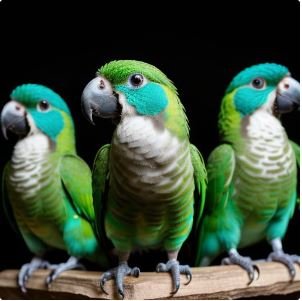
2. History and Origin
Evolution of Green-Cheeked Conures
Green cheeked conures have a rich evolutionary history, tracing back to their native habitats in South America. Over time, breeders have selectively bred these birds, leading to various mutations, including the Turquoise.
Discovery and Development of Turquoise Mutation
The Turquoise mutation, characterized by its stunning blue-green plumage, was discovered through careful breeding practices to enhance the visual appeal of Green Cheeked Conures.
3. Are Green Cheeked Conure Turquoise Good Pets?
Characteristics That Make Them Ideal Companions
Turquoise Green Cheeked Conures possess a myriad of traits that make them cherished companions among bird enthusiasts. Their endearing personalities and engaging behaviors forge strong bonds with their human caregivers, enriching the lives of both parties.
Affectionate Nature
Turquoise Green Cheeked Conures are inherently affectionate creatures, often seeking out physical contact and closeness with their owners. They enjoy cuddling, nuzzling, and preening their human companions, fostering a deep sense of connection and companionship. This affectionate nature strengthens the bond between the bird and its owner, creating a mutually rewarding relationship built on trust and love.

Playful Demeanor
Renowned for their playful antics and curious nature, Turquoise Green Cheeked Conures bring a sense of joy and amusement into the home. They delight in exploring their surroundings, investigating new toys, and engaging in interactive games with their owners. This playful demeanor not only provides entertainment but also encourages physical activity and mental stimulation, promoting overall health and well-being.
Low Noise Levels
Unlike some other parrot species known for their loud vocalizations, Turquoise Green Cheeked Conures exhibit relatively low noise levels, making them well-suited for apartment living or households with noise-sensitive individuals. While they do vocalize, their sounds are typically softer and more melodic, consisting of chirps, whistles, and gentle squawks. This quieter disposition enhances their appeal as companions, allowing for peaceful coexistence in various living environments.
Intelligence and Curiosity
Turquoise Green Cheeked Conures possess remarkable intelligence and a natural curiosity about their surroundings. They enjoy problem-solving activities, such as puzzle toys or foraging games, that challenge their cognitive abilities and keep them mentally stimulated. This intellectual curiosity not only entertains the birds but also fosters a sense of engagement and enrichment, ensuring they lead fulfilling and contented lives in captivity.
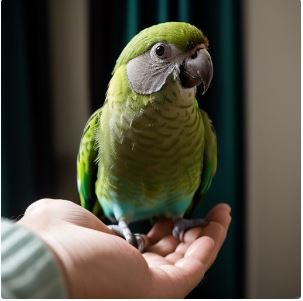
Emotional Sensitivity
These birds are emotionally sensitive creatures, attuned to the moods and feelings of their human companions. They possess a remarkable ability to empathize and offer comfort during times of distress or sadness. Their empathetic nature allows them to form deep emotional bonds with their owners, providing solace and support through life’s ups and downs. This emotional sensitivity strengthens the human-bird bond, creating a relationship based on mutual understanding and compassion.
4. Considerations Before Getting a Turquoise Green Cheeked Conure
Time Commitment
Owning a Turquoise Green Cheeked Conure requires significant daily interaction and care to prevent boredom and ensure well-being.
Space Requirements
Turquoise Green Cheeked Conures need ample space for movement and exercise, both within their cage and during out-of-cage time.
Potential Allergies and Sensitivities
Prospective owners should consider potential allergies or sensitivities to bird dander, feathers, or dust associated with Turquoise Green Cheeked Conures.
5. Talking Ability and Vocalizations
Natural Vocalizations
Turquoise Green Cheeked Conures emit a range of natural vocalizations, including chirps, whistles, and squawks.
Limited Talking Ability
While some individuals may learn a few words or phrases, Turquoise Green Cheeked Conures are not renowned for their talking abilities compared to some other parrot species.
Individual Variability
When it comes to the talking potential of Turquoise Green Cheeked Conures, individual variability plays a significant role. While some may have limited talking ability, others may exhibit more impressive mimicry skills. However, they can learn a few words or phrases with patience and consistent training. The extent of their talking ability varies from bird to bird, with some capable of learning a handful of words or simple phrases, while others may not show much interest in talking at all. It’s essential to keep in mind that talking is just one aspect of their charm, and each bird has its own unique personality and capabilities beyond vocalizations.
6. Housing and Cage Setup
Ideal Cage Dimensions
Provide a spacious cage with dimensions of at least 24 inches wide, 24 inches deep, and 36 inches tall to accommodate the active nature of Turquoise Green Cheeked Conures.
Ensure the cage bars are spaced no more than 5/8 inch apart to prevent escape or injury.
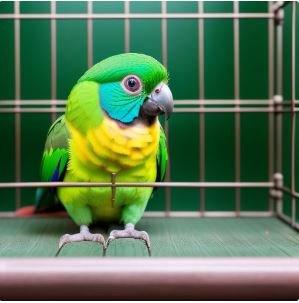
Cage Setup
Place the cage in a draft-free area away from direct sunlight and household hazards such as drafts, kitchen fumes, or cigarette smoke.
Line the bottom of the cage with safe bedding material such as paper or hardwood chips to absorb waste and facilitate cleaning.
Position perches at varying heights and thicknesses to encourage natural perching behavior and foot exercise.
Provide multiple food and water dishes placed at different levels of the cage to prevent territorial disputes and encourage foraging behavior.
Include a secure door latch and lock to prevent accidental escape.
Toys
Include a variety of perches made from natural wood or bird-safe materials to promote foot health and prevent pressure sores.
Offer interactive toys such as puzzle feeders, chew toys, and foraging toys to keep your Turquoise Green Cheeked Conure mentally stimulated and entertained.
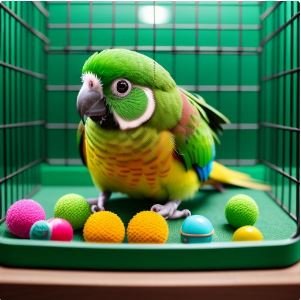
Rotate toys regularly to prevent boredom and encourage exploration and play.
Avoid toys with small parts or toxic materials that could pose a choking hazard or lead to poisoning if ingested.
7. Diet and Nutrition for Turquoise Green Cheeked Conures
Primary Diet Requirements
Offer a high-quality pellet diet formulated specifically for small to medium-sized parrots, such as Turquoise green-cheeked Conures.
Ensure pellets make up the majority of their diet to provide essential nutrients, vitamins, and minerals.
Limit seed consumption to no more than 10-20% of their daily diet to prevent obesity and nutritional imbalances.
Fresh Fruits and Vegetables
Provide a variety of fresh fruits and vegetables daily, such as apples, bananas, oranges, grapes, carrots, broccoli, and leafy greens.
Wash and chop fruits and vegetables into bite-sized pieces to make them easier for your Turquoise green-cheeked Conure to eat.
Protein Sources
Offer occasional protein sources such as cooked eggs, cooked chicken, or small amounts of cooked beans or legumes for added variety and nutrition.
Avoid feeding high-fat or high-sodium protein sources such as processed meats or salty snacks.
Treats and Supplements
Offer occasional treats such as nuts (in moderation), seeds, or dried fruits as a special reward or for training purposes.
Limit the amount of treats to avoid weight gain and ensure they do not exceed 10% of their total daily diet.
Provide access to cuttlebones or mineral blocks for added calcium and beak maintenance.
Fresh Water
Ensure access to clean, fresh water at all times, replacing it daily to prevent contamination or bacterial growth.
Use a water bottle or a shallow dish that is securely attached to the cage to prevent spills and keep water clean.
8. Breeding and Reproduction
Breeding Considerations
Ensure that both the male and female Turquoise Green Cheeked Conures are mature and in good health before attempting to breed.
Provide a suitable nesting box filled with nesting material, such as shredded paper or untreated wood shavings, to encourage nesting behavior.
Care During Nesting and Hatching
Monitor the nesting pair closely during the nesting period to ensure they have access to fresh food, water, and a stress-free environment.
Avoid disturbing the nesting area once the eggs are laid to prevent abandonment or stress-induced egg breakage.
9. Benefits of Owning a Green Cheeked Conure Turquoise
Turquoise Green Cheeked Conures form deep bonds with their owners, providing companionship and emotional support.
Entertainment Value
Their playful antics and charming personalities offer endless entertainment for their owners.
Therapeutic Effects
Interacting with Turquoise Green Cheeked Conures can have therapeutic benefits, reducing stress and promoting relaxation.
Educational Opportunities
Owning these birds provides valuable educational opportunities, allowing owners to learn more about avian behavior and care.
Sense of Responsibility
Caring for Turquoise Green Cheeked Conures instills a sense of responsibility and commitment in owners.
Social Connection
Bird enthusiasts can connect with other owners and enthusiasts through clubs, forums, and social media groups dedicated to Green Cheeked Conures.
10. Potential Disadvantages
Noise Level
While quieter than some other parrot species, Turquoise Green Cheeked Conures can still be noisy at times, especially during periods of excitement.
Mess and Dander
Like all birds, Turquoise Green Cheeked Conures produce dander and feathers, requiring regular cleaning to maintain a tidy living environment.
Time and Attention Demands
These birds thrive on social interaction and require daily attention and stimulation from their owners.
Potential Health Issues
Owners should be aware of common health issues affecting Green Cheeked Conures, such as respiratory infections and feather plucking.
Destructive Behaviors
Without proper enrichment and stimulation, Turquoise Green Cheeked Conures may engage in destructive behaviors such as chewing on furniture or feathers.
Need for Socialization
Regular socialization is essential for preventing behavioral problems and ensuring the well-being of Turquoise Green Cheeked Conures.
11. Compatibility with Other Pets
Suitable Companions
Other Birds
Turquoise Green Cheeked Conures can coexist peacefully with other birds of similar size and temperament.
Cat and Dog Considerations
With proper introduction and supervision, Turquoise Green Cheeked Conures can live harmoniously with cats and dogs that are accustomed to birds.
Small Mammals
These birds can also get along well with small mammals such as guinea pigs or rabbits.
Incompatible Pets:
Larger Birds.
Turquoise Green Cheeked Conures may feel intimidated by larger bird species and may not thrive in their presence.
Predatory Pets
Pets with a strong predatory instinct, such as ferrets or snakes, pose a risk to Turquoise Green Cheeked Conures and should be kept separate.
High-Prey Drive Dogs
Dogs with a high prey drive may view Turquoise Green Cheeked Conures as potential prey, posing a danger to their safety.
12. Cost of Ownership
Initial Investment
The initial investment includes purchasing the Turquoise Green Cheeked Conure, which typically ranges from $150 to $500, depending on factors such as age, mutation, and breeder reputation.
Additional expenses may include purchasing a suitable cage, which can cost between $100 to $300, depending on size and quality.
Ongoing Expenses
Ongoing expenses include the cost of food, which can range from $20 to $50 per month, depending on the quality and variety of diet provided.
Veterinary care, including annual check-ups and potential emergency medical expenses, should be budgeted for and can vary widely depending on the health of the bird and the region.
13. Legal Considerations and Regulations
Permits and Licenses
Depending on your location, owning Turquoise Green Cheeked Conures may require permits or licenses to ensure compliance with local wildlife regulations.
Compliance with Wildlife Protection Laws
It’s essential to familiarize yourself with wildlife protection laws and regulations governing the ownership and breeding of Turquoise Green Cheeked Conures to avoid legal issues.
14. User Testimonials and Their Advice
Testimonial 1: Emily, Green Cheeked Conure Turquoise Owner
“I’ve had my Green Cheeked Conure Turquoise for two years now, and he’s been the most delightful addition to our family! He’s incredibly affectionate and loves cuddling up on my shoulder while I work.
Advice for owner:
My suggestion to new owners is to invest in plenty of interactive toys and spend quality time bonding with your bird every day. It truly makes a difference in their happiness and behavior.”
Testimonial 2: Mark, First-Time Bird Owner
“As a first-time bird owner, I was a bit nervous about bringing a Green Cheeked Conure Turquoise into my home, but I couldn’t be happier with my decision! My bird has brought so much joy and laughter into my life with his playful antics and sweet chirps.
Advice for owner:
My advice to fellow owners is to be patient and consistent with training, especially when it comes to teaching them new tricks or behaviors. It’s rewarding to see their progress over time!”
Testimonial 3: Sarah and Tom, Multi-Pet Household
“Our Green Cheeked Conure Turquoise, Mango, gets along famously with our other pets, including our cat and dog! We introduced them slowly and supervised their interactions at first, but now they’re the best of friends.
Advice for owner:
Our tip for owners with multiple pets is to create designated safe spaces for each animal to retreat to when they need a break, ensuring everyone feels comfortable and secure in their environment.”
Testimonial 4: Alex, Experienced Bird Enthusiast
“Having owned several parrots over the years, I can confidently say that Green Cheeked Conure Turquoise is among the most charming and lovable species out there! They’re intelligent, affectionate, and always full of surprises.
Advice for owner:
One piece of advice I’d give to owners is to provide plenty of mental stimulation through puzzle toys, foraging activities, and training sessions. Keeping their minds engaged is key to preventing boredom and promoting a happy, well-adjusted bird.”
Conclusion
Owning a Green Cheeked Conure Turquoise can be a rewarding experience filled with companionship, joy, and affection. These charming birds bring vibrancy into your life with their playful antics, affectionate nature, and unique personalities. However, it’s essential to consider the time, effort, and financial commitment required to provide optimal care for your feathered friend. By understanding their needs and investing in their well-being, you can enjoy a fulfilling and enriching bond with your Turquoise Green Cheeked Conure for years to come. Whether it’s their striking beauty, entertaining behaviors, or heartfelt companionship, these delightful birds have a special way of brightening every day.
FAQs: Green Cheeked Conure Turquoise
Green Cheeked Conures typically live for 15-20 years with proper care. Regular vet check-ups and a balanced diet can help maximize their lifespan. While Turquoise Conures are known for their friendly demeanor, they may require some experience in bird care. Consider starting with a more beginner-friendly species for your first bird. You can determine the gender of your Green Cheeked Conure Turquoise physically by observing subtle differences in coloration, tail feather length, and head shape. Males may have brighter plumage and longer tail feathers, while females may have slightly smaller heads. However, for definitive results, consider DNA testing or consult an avian veterinarian. Keep an eye out for changes in behavior, such as lethargy, loss of appetite, or abnormal droppings. Any unusual symptoms should prompt a visit to an avian vet for evaluation. "Yes, Green Cheeked Conures have the potential to learn basic words and phrases with patient training. Consistent repetition and positive reinforcement can help develop their talking abilities."
How long do Green Cheeked Conures live?
Are Turquoise Conures suitable for first-time bird owners?
How can I tell the gender of my Green Cheeked Conure Turquoise?
What are some signs of illness to watch out for?
Can Green Cheeked Conures learn to talk?
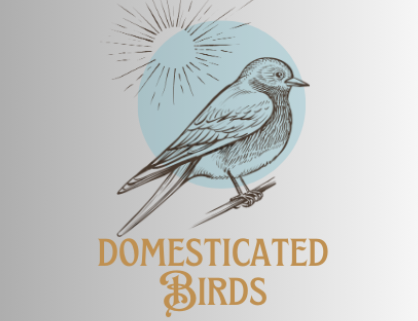
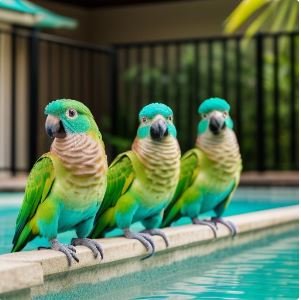
Nice work